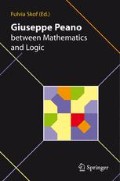Abstract
First, Peano’s geometrical calculus theory is a general theory which is of intrinsic mathematical interest and which is also applied to mechanics and to physics. Peano’s contributions, which come from an elaboration of Grassmann’s ideas, consist in an Euclidean interpretation of relative concepts. Moreover, in this context, Peano proves important fundamental theorems of projective geometry. For this reason, Peano’s geometrical calculus has an implicit foundational interest. In our opinion, the protophysical role of Euclidean geometry in Peano’s works is essential and decisive. He distinguishes position geometry from Euclidean geometry, and from a theoretical point of view, it is appropriate. In his ‘Sui fondamenti della geometria’ the congruence theory is well determined and regulated. Classical geometry constitutes the crucial model for the study of the foundations of geometry. Even Hilbert, deep down, takes Euclid into account20. During this period, we have many proposals of systems with different essential or primitive notions and axioms. Hence, we can observe “equivalent theories” for the foundation of elementary geometry, and in this way we have a “theoretical relativism” regarding the choice of primitive elements and fundamental axioms. This is epistemologically and historiographically21 very important22.
Access this chapter
Tax calculation will be finalised at checkout
Purchases are for personal use only
Preview
Unable to display preview. Download preview PDF.
References
H. Grassmann (1862), 415; (1896), 11–12.
The Genocchi-Bellavitis letters are analyzed in G. Canepa, P. Freguglia (1991), 211–219.
C. Burali-Forti (1926), 5–6.
Peano (1888a), 30.
Peano (1888a), 107.
Peano (1888a), 110–111.
G. Bellavitis (1854), 13–85.
Peano (1888a), 47.
Peano (1888a), 47: “Supposto ABC non nullo, la condizione necessaria e sufficiente affinchè i tre punti A′B′C′ siano in linea retta, ossia A′B′C′ = 0, è l’annullarsi del coefficiente di ABC. Dunque se i punti A′B′C′, che stanno sui lati BC, CA, AB del triangolo ABC sono in linea retta, si ha \( \frac{{BA'}} {{A'C}} \cdot \frac{{CB'}} {{B'A}}\frac{{AC'}} {{C'B}} = - 1 \) e vice versa.”
Peano (1888a), 92.
Peano (1888a), 95.
C. Burali-Forti, R. Marcolongo (1909), 27–45.
C. Burali-Forti, R. Marcolongo (1912), IX (footnote 4).
See e. g. M. Pieri (1900a); (1901a), 367–404; (1908a), 345–450.
D. Palladino, § 5 Appendix, in M. Borga, P. Freguglia, D. Palladino (1985), 244–250.
G. Veronese (1891), Parte I, Libro I, Capitolo I, § 1, 209: “Oss. emp. Alla presenza dei corpi fuori di noi, che ci appariscono per mezzo dei sensi, specialmente per mezzo della vista e del tatto, è collegata l’idea di ciò che li contiene, e, si chiama ambiente esterno o spazio intuitivo, nel quale i corpi occupano ciscuno un determinato posto o luogo.” See also P. Cantù, Giuseppe Veronese e i fondamenti della geometria, Milano, Unicopli, 1999.
G. Veronese (1891), 13–14: “Data una cosa A determinata, se non è stabilito che A è il gruppo di tutte le cose possibili che vogliamo considerare, possiamo pensarne un’altra non contenuta in A (vale a dire fuori di A) e indipendente da A.”
G. Peano (1892n), Review G. Veronese (1891), 144: “Data una classe A, se essa non contiene tutti gli oggetti, allora essa non contiene tutti gli oggetti”. Actually in this review Peano blasts the Veronese’s treatise.
Cf. U. Bottazzini (2000), 123–148.
See V. Benci, P. Freguglia, Modelli e realtà: una riflessione sulle nozioni di spazio e di tempo, Bollati Boringhieri, Torino, 2011.
Author information
Authors and Affiliations
Editor information
Editors and Affiliations
Rights and permissions
Copyright information
© 2011 Springer-Verlag Italia
About this chapter
Cite this chapter
Freguglia, P. (2011). Geometric Calculus and Geometry Foundations in Peano. In: Skof, F. (eds) Giuseppe Peano between Mathematics and Logic. Springer, Milano. https://doi.org/10.1007/978-88-470-1836-5_5
Download citation
DOI: https://doi.org/10.1007/978-88-470-1836-5_5
Publisher Name: Springer, Milano
Print ISBN: 978-88-470-1835-8
Online ISBN: 978-88-470-1836-5
eBook Packages: Mathematics and StatisticsMathematics and Statistics (R0)

